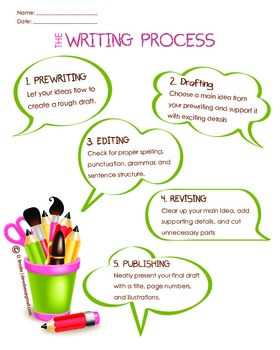Unlocking the Power of the Writing Process
Effective writing is a crucial aspect of communication, and understanding the writing process is essential for producing high-quality content. The 5 steps in the writing process – idea generation, outlining, writing, revising, and editing – provide a structured approach to content creation. By following this process, writers can develop a clear and concise message, engage their audience, and convey their ideas effectively.
A well-structured writing process helps writers to overcome common challenges such as writer’s block, procrastination, and self-doubt. It enables them to organize their thoughts, prioritize their ideas, and create a logical flow of information. This, in turn, helps to ensure that their content is well-structured, easy to follow, and free of errors.
Moreover, the writing process allows writers to refine their ideas and make necessary adjustments before finalizing their content. This iterative approach enables writers to produce high-quality content that meets their goals and objectives. Whether it’s writing an article, a blog post, or a book, the writing process is an essential tool for writers to produce engaging and effective content.
By mastering the 5 steps in the writing process, writers can take their content to the next level. They can create compelling narratives, engage their audience, and convey their ideas with clarity and precision. The writing process is a powerful tool that can help writers to achieve their goals and produce high-quality content that resonates with readers.
Understanding the writing process is not just about following a set of steps; it’s about developing a mindset that enables writers to approach their work with clarity, creativity, and purpose. By embracing this mindset, writers can unlock their full potential and produce content that makes a lasting impact.
Step into the World of Ideas: How to Generate and Develop Your Concepts
The first step in the 5 steps in the writing process is idea generation. This stage is crucial in developing a solid foundation for your content. To generate ideas, writers can use various techniques such as brainstorming, mind mapping, and researching. Brainstorming involves freely associating ideas and concepts to come up with a list of potential topics. Mind mapping, on the other hand, involves visually organizing ideas and concepts to identify relationships and patterns.
Researching is another effective way to generate ideas. This involves gathering information from various sources, including books, articles, and online resources. By researching, writers can gain a deeper understanding of their topic and identify gaps in existing knowledge. This can help them to develop unique and insightful ideas that add value to their content.
Once ideas have been generated, the next step is to develop and refine them. This involves evaluating the ideas, identifying the most promising ones, and developing them into a cohesive concept. Writers can use techniques such as free writing, journaling, and outlining to develop their ideas and create a clear direction for their content.
Developing ideas is an iterative process that requires patience, persistence, and creativity. By using various techniques and strategies, writers can generate and develop ideas that form the foundation of high-quality content. This, in turn, can help them to achieve their writing goals and produce content that resonates with their audience.
Effective idea generation and development are critical components of the writing process. By mastering these skills, writers can create content that is engaging, informative, and memorable. Whether it’s writing an article, a blog post, or a book, the ability to generate and develop ideas is essential for producing high-quality content that meets the needs of the audience.
Organizing Your Thoughts: The Art of Outlining and Structuring Your Content
Once ideas have been generated and developed, the next step in the 5 steps in the writing process is to organize them into a logical and coherent structure. This is where outlining and structuring come into play. An outline is a roadmap that helps writers to organize their ideas, prioritize their content, and create a clear direction for their writing.
A well-structured outline should include headings, subheadings, and bullet points that break down the content into manageable chunks. This helps writers to visualize their content, identify gaps in their argument, and ensure that their ideas flow logically. By creating an outline, writers can also identify areas where they need to conduct further research or gather more information.
When it comes to structuring content, there are several techniques that writers can use to create a clear and logical flow. One technique is to use transitions to connect ideas and paragraphs, creating a smooth and cohesive narrative. Another technique is to use headings and subheadings to break up the content and create a clear hierarchy of information.
Effective outlining and structuring are critical components of the writing process. By taking the time to organize their ideas and create a clear structure, writers can produce content that is engaging, informative, and easy to follow. This, in turn, can help them to achieve their writing goals and produce content that resonates with their audience.
There are several tools and techniques that writers can use to create an effective outline and structure their content. These include mind mapping, outlining software, and writing templates. By using these tools and techniques, writers can streamline their writing process, save time, and produce high-quality content that meets their goals.
Bringing Your Ideas to Life: The Craft of Writing and Revising
With a solid outline in place, the next step in the 5 steps in the writing process is to bring your ideas to life through writing and revising. This stage is where you transform your ideas into engaging content that resonates with your audience. To achieve this, it’s essential to focus on tone, style, and voice.
Tone refers to the attitude or feeling conveyed through your writing. It can be formal or informal, serious or humorous, depending on your audience and purpose. Style, on the other hand, refers to the way you express yourself through language, including your use of vocabulary, syntax, and grammar. Voice is the unique perspective or personality that shines through in your writing.
When writing, it’s essential to consider your audience and tailor your tone, style, and voice accordingly. This will help you to connect with your readers and convey your message effectively. Additionally, using techniques such as storytelling, metaphors, and analogies can help to make your content more engaging and memorable.
Revising is an essential part of the writing process. It involves reviewing your content to ensure that it is clear, concise, and free of errors. This stage is where you refine your ideas, clarify your message, and strengthen your writing. By revising your work, you can ensure that your content is polished and professional, making it more likely to resonate with your audience.
Effective revising involves taking a step back from your work and reviewing it objectively. This can involve getting feedback from others, using editing software, or taking a break from your work to approach it with fresh eyes. By revising your work, you can ensure that your content is the best it can be, making it more likely to achieve your writing goals.
Refining Your Work: The Importance of Editing and Proofreading
Once the writing stage is complete, it’s essential to refine the content through editing and proofreading. This step is crucial in the 5 steps in the writing process, as it ensures that the final product is error-free, clear, and engaging. Editing involves reviewing the content for clarity, coherence, and overall flow, while proofreading focuses on detecting and correcting grammatical, punctuation, and spelling errors.
A thorough editing process involves checking the content for consistency, tone, and style. It’s also essential to verify facts, statistics, and quotes to ensure accuracy. On the other hand, proofreading requires a meticulous review of the text to catch any errors that may have been overlooked during the editing stage. This includes checking for subject-verb agreement, tense consistency, and proper punctuation.
To refine the content effectively, it’s recommended to take a break from the writing process before editing and proofreading. This allows for a fresh perspective and helps to identify errors and areas for improvement that may have been missed initially. Additionally, seeking feedback from others can be incredibly valuable in refining the content. This can include sharing the work with colleagues, peers, or mentors to get their input and suggestions.
Some effective strategies for editing and proofreading include reading the content aloud, using grammar and spell check tools, and creating a checklist of common errors to watch out for. It’s also essential to keep the target audience in mind during this stage, ensuring that the content is tailored to their needs and expectations.
By dedicating sufficient time and effort to editing and proofreading, writers can significantly improve the quality of their content. This, in turn, can enhance the overall impact and effectiveness of the writing, whether it’s intended for academic, professional, or personal purposes. As part of the 5 steps in the writing process, refining the content through editing and proofreading is a critical step that should not be overlooked.
Putting it all Together: How to Use the Writing Process to Achieve Your Goals
By now, it’s clear that the 5 steps in the writing process are essential for producing high-quality content. From generating and developing ideas to editing and proofreading, each stage plays a critical role in creating engaging and effective writing. By understanding and applying these steps, writers can overcome common challenges and achieve their goals.
One of the key benefits of using a structured writing process is that it helps writers stay focused and organized. By breaking down the writing process into manageable stages, writers can avoid feeling overwhelmed and ensure that their content meets their objectives. Additionally, a well-structured approach enables writers to identify and address potential issues early on, saving time and effort in the long run.
Another advantage of using the 5 steps in the writing process is that it allows writers to refine their skills and develop their unique voice. By practicing and applying the techniques and strategies discussed in this article, writers can improve their writing style, tone, and overall quality of their content. This, in turn, can help writers build their confidence and establish themselves as authorities in their field.
To get the most out of the writing process, it’s essential to be flexible and adaptable. Writers should be willing to make changes and adjustments as needed, and be open to feedback and suggestions from others. By embracing a growth mindset and being committed to continuous improvement, writers can achieve their goals and produce content that resonates with their audience.
In conclusion, the 5 steps in the writing process offer a powerful framework for producing high-quality content. By understanding and applying these steps, writers can overcome common challenges, achieve their goals, and develop their skills and voice. Whether you’re a seasoned writer or just starting out, the writing process is an essential tool that can help you succeed in your writing endeavors.
By incorporating the 5 steps in the writing process into your writing routine, you’ll be well on your way to producing content that engages, informs, and inspires your audience. Remember to stay focused, be flexible, and keep practicing – with dedication and persistence, you can achieve your writing goals and become a skilled and effective writer.
Overcoming Common Challenges: Tips for Staying on Track
Despite the best intentions, writers often face challenges that can hinder their progress and impact the quality of their content. Writer’s block, procrastination, and self-doubt are common obstacles that can be overcome with the right strategies and mindset. By understanding the 5 steps in the writing process, writers can better navigate these challenges and stay on track.
One of the most effective ways to overcome writer’s block is to take a break and revisit the idea generation stage. Brainstorming, mind mapping, and researching can help stimulate new ideas and get the creative juices flowing again. Additionally, breaking down the writing process into smaller, manageable tasks can help make the task less daunting and more achievable.
Procrastination is another common challenge that writers face. To overcome this, it’s essential to set clear goals and deadlines, and create a schedule that allows for regular writing sessions. Using the Pomodoro Technique, which involves working in focused 25-minute increments, can also help stay focused and avoid distractions.
Self-doubt is a natural part of the writing process, but it can be debilitating if left unchecked. To overcome self-doubt, it’s essential to focus on the process, rather than the outcome. By concentrating on the 5 steps in the writing process, writers can build confidence in their abilities and produce high-quality content.
Another effective way to stay on track is to seek feedback from others. Sharing work with peers, mentors, or editors can provide valuable insights and help identify areas for improvement. Additionally, joining a writing community or finding a writing buddy can provide motivation and support throughout the writing process.
Finally, it’s essential to remember that writing is a process that takes time, effort, and practice. By being patient, persistent, and kind to oneself, writers can overcome common challenges and produce content that resonates with their audience. By incorporating the 5 steps in the writing process into their writing routine, writers can stay on track and achieve their writing goals.
Conclusion: Mastering the Writing Process for Success
In conclusion, the 5 steps in the writing process are essential for producing high-quality content that resonates with readers. By understanding and applying these steps, writers can overcome common challenges, achieve their goals, and develop their skills and voice. Whether you’re a seasoned writer or just starting out, the writing process is a powerful tool that can help you succeed in your writing endeavors.
By incorporating the 5 steps in the writing process into your writing routine, you’ll be well on your way to producing content that engages, informs, and inspires your audience. Remember to stay focused, be flexible, and keep practicing – with dedication and persistence, you can achieve your writing goals and become a skilled and effective writer.
The key to mastering the writing process is to be patient, persistent, and kind to yourself. Don’t be afraid to make mistakes or try new things – it’s all part of the learning process. With time and practice, you’ll develop your unique voice and style, and your writing will become more confident and effective.
As you continue on your writing journey, remember that the 5 steps in the writing process are always available to guide you. Whether you’re working on a blog post, article, or book, these steps will help you stay on track and produce high-quality content that resonates with your audience. So, keep writing, learning, and growing – and watch your writing skills soar!
By following the 5 steps in the writing process, you’ll be able to produce content that is engaging, informative, and effective. You’ll be able to communicate your ideas and messages with clarity and precision, and connect with your audience in a meaningful way. So, start using the writing process today, and watch your writing skills transform!




